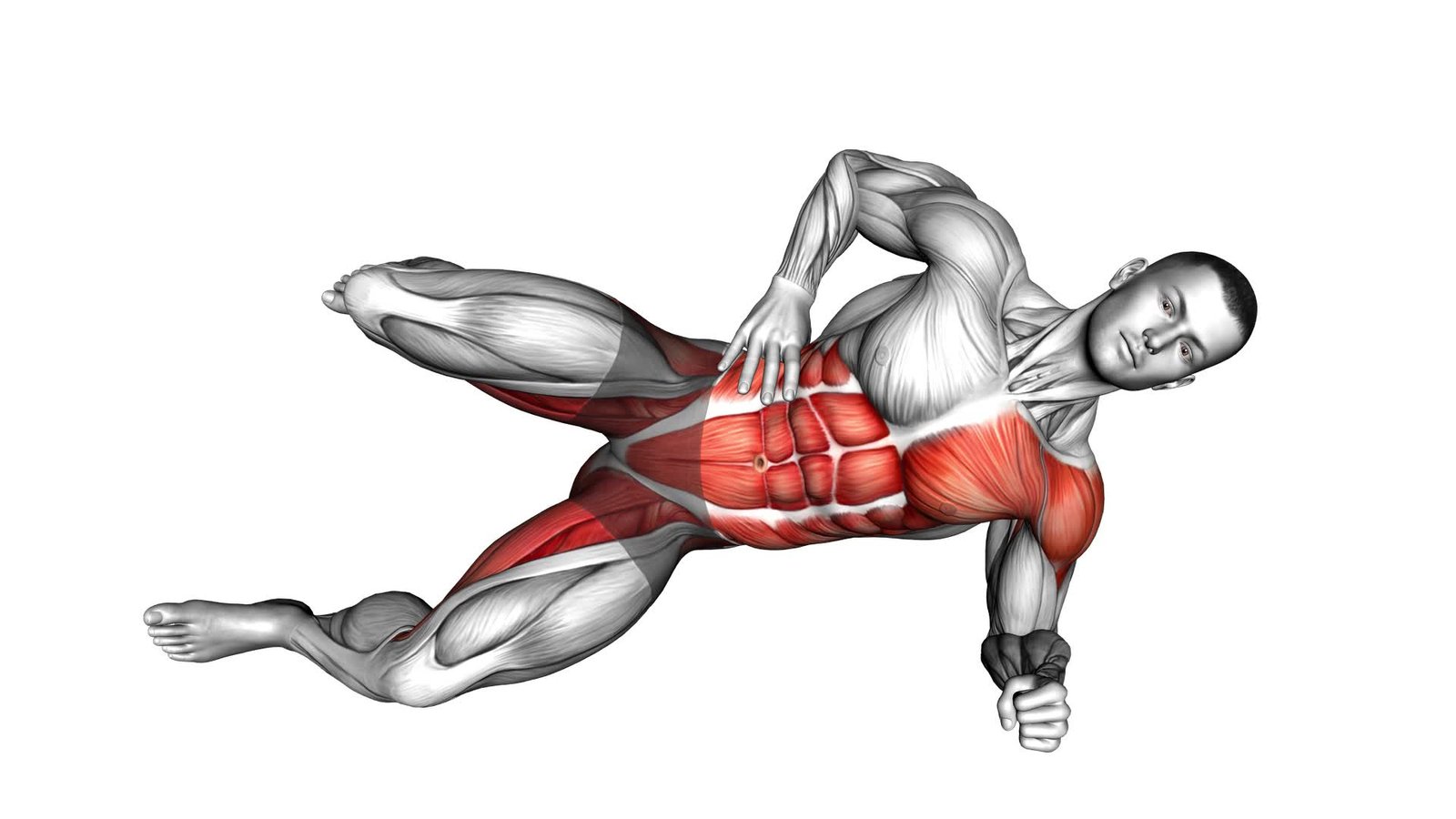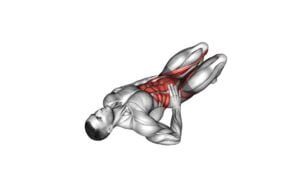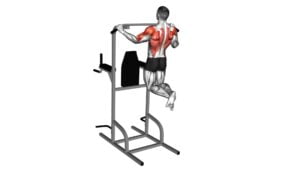Side Clamp (male) – Video Exercise Guide & Tips

Get ready to strengthen your core with the Side Clamp exercise!
Watch This Exercise Video
In this video exercise guide, we'll show you the proper form and technique for this effective workout. You'll discover the benefits of incorporating the Side Clamp into your fitness routine, along with modifications and variations to challenge yourself.
Avoid common mistakes and get the most out of this exercise with our expert tips.
Let's get started and take your fitness to the next level!
Key Takeaways
- Side Clamp exercise engages and strengthens core muscles.
- Proper form and technique, including maintaining elbow placement and a straight line from head to heels, is important for maximizing the benefits of the exercise.
- Controlled breathing, focusing on diaphragmatic breathing, is essential during the Side Clamp exercise.
- Variations and modifications, such as adding resistance bands or incorporating leg lifts, can challenge core strength and improve stability.
Benefits of the Side Clamp Exercise
You will experience enhanced stability and core strength when practicing the Side Clamp exercise. This exercise offers a multitude of benefits, making it an excellent addition to your fitness routine.
One of the key benefits of the Side Clamp exercise is its ability to engage and strengthen your core muscles. By targeting the muscles in your abdomen, back, and pelvis, this exercise helps to improve your overall core stability. Strong core muscles not only provide you with better balance and posture, but they also play a crucial role in preventing injuries and reducing lower back pain.
In addition to core engagement, the Side Clamp exercise also helps to tone and strengthen your obliques, which are the muscles on the sides of your abdomen. This can give you a more defined waistline and contribute to a more sculpted appearance. Moreover, this exercise also works your glutes, hips, and thighs, providing a comprehensive workout for your lower body.
Equipment Needed for the Side Clamp Exercise
To perform the Side Clamp exercise, all you need is a resistance band. The resistance band provides the necessary tension and resistance to target the muscles effectively. It's a versatile and portable piece of equipment that can be easily incorporated into your workout routine.
If you don't have a resistance band, there are alternative exercises that can target similar muscle groups. Side planks, Russian twists, and standing side bends are all effective alternatives to the Side Clamp exercise. These exercises engage the oblique muscles and promote core stability.
When it comes to choosing the appropriate weight for the Side Clamp exercise, it's important to consider your fitness level and goals. For beginners, starting with a lighter resistance band is recommended. As you progress and become stronger, you can increase the resistance to challenge your muscles further. It's important to choose a weight that allows you to perform the exercise with proper form and control.
Proper Form and Technique for the Side Clamp Exercise
To perform the Side Clamp exercise with proper form and technique, there are a few key points you need to focus on.
First, it's important to pay attention to your elbow placement. Make sure your elbow is positioned directly under your shoulder to maintain stability and prevent strain.
Additionally, engage your core throughout the exercise to ensure proper form and maximize the benefits of the exercise.
Elbow Placement Importance
Proper elbow placement is crucial for maintaining optimal form and technique in the Side Clamp exercise. When performing this exercise, it's important to pay attention to the alignment of your elbows to ensure maximum muscle activation and prevent injuries.
Here are three reasons why elbow placement is important:
- Improved muscle targeting: By keeping your elbows in the correct position, you can effectively target the desired muscles, such as the biceps and triceps. This ensures that you're getting the most out of your workout and maximizing muscle activation.
- Reduced strain on joints: Proper elbow alignment helps distribute the load evenly, reducing the strain on your joints. This not only minimizes the risk of injury but also allows you to perform the exercise with more ease and comfort.
- Enhanced stability and balance: When your elbows are properly aligned, it promotes stability and balance throughout the exercise. This enables you to maintain control and perform the movement smoothly, optimizing the effectiveness of the Side Clamp exercise.
Core Engagement and Stability
Engage your core and maintain stability for optimal form and technique in the Side Clamp exercise.
Core activation is crucial in this exercise as it helps to stabilize your body and protect your lower back. To engage your core, imagine pulling your belly button towards your spine and brace your abs as if preparing for a punch. This will help to create a solid foundation and improve your overall stability.
Stability training is essential for proper execution of the Side Clamp exercise, as it involves balancing on one side of your body. By focusing on maintaining stability, you can effectively target your obliques and strengthen your core muscles.
Remember to breathe deeply and maintain good posture throughout the exercise to maximize the benefits.
Modifications and Variations of the Side Clamp Exercise
Make the Side Clamp exercise more challenging by incorporating resistance bands. This simple modification can help you take your workout to the next level and target your muscles even more effectively. Here are three variations of the Side Clamp exercise that you can try:
- Resistance band Side Clamp: Attach a resistance band to a sturdy anchor point and loop it around your legs while performing the Side Clamp. The resistance from the band will add extra tension to your muscles, making them work harder.
- Weighted Side Clamp: Hold a dumbbell or kettlebell in your top hand while performing the Side Clamp. The added weight will increase the intensity of the exercise and help you build strength in your core and obliques.
- Elevated Side Clamp: Elevate your feet by placing them on a bench or step while performing the Side Clamp. This variation increases the range of motion and engages your core muscles even more.
Incorporating these modifications and variations into your Side Clamp routine will challenge your muscles in new ways and keep your workouts interesting. Remember to start with lighter resistance or weight and gradually increase as you become more comfortable with the exercise.
Common Mistakes to Avoid During the Side Clamp Exercise
Avoiding these common mistakes will help you maximize the effectiveness of the Side Clamp exercise. To ensure you're getting the most out of this exercise, it's important to be aware of the common mistakes people make and how to improve upon them.
One common mistake is using improper form. It's important to maintain a straight line from your head to your heels, with your body in a plank position. Avoid arching your back or dropping your hips, as this can put unnecessary strain on your lower back. Instead, engage your core muscles and keep your body aligned.
Another mistake to avoid is rushing through the exercise. The Side Clamp should be performed slowly and controlled, with a focus on engaging the targeted muscles. By taking your time and maintaining proper form, you'll increase the effectiveness of the exercise and reduce the risk of injury.
Lastly, it's important to remember to breathe throughout the exercise. Holding your breath can increase tension in your muscles and make the exercise more difficult. Instead, take slow, deep breaths and exhale as you contract your muscles.
Tips for Getting the Most Out of the Side Clamp Exercise
To get the most out of the Side Clamp exercise, it's important to focus on proper form techniques. Ensure that your body is aligned correctly and engage your core muscles throughout the exercise.
Additionally, pay attention to your breathing techniques, exhaling as you contract your muscles and inhaling as you release.
For advanced users, try incorporating variations such as adding resistance or increasing the duration of the exercise to challenge yourself further.
Proper Form Techniques
Achieving optimal results during the Side Clamp exercise requires a focus on precision and proper technique. To ensure you get the most out of this exercise and maximize your core activation and muscle engagement, here are some tips:
- Maintain proper alignment: Keep your body in a straight line from your head to your heels. Avoid sagging or arching your back.
- Engage your core: Throughout the exercise, actively engage your abdominal muscles by pulling your belly button towards your spine. This will help stabilize your body and increase the intensity of the exercise.
- Control your breathing: Breathe deeply and exhale as you contract your muscles. This will enhance your mind-muscle connection and improve your overall performance.
By following these proper form techniques, you'll be able to perform the Side Clamp exercise effectively and achieve the desired results.
Breathing Techniques During Exercise
Maintain a controlled and rhythmic breathing pattern to optimize your performance and enhance the effectiveness of the Side Clamp exercise.
Proper breath control is essential to ensure oxygen delivery to your muscles and prevent fatigue.
During the exercise, focus on diaphragmatic breathing, which involves taking deep breaths that expand your abdomen rather than shallow breaths that only fill your chest.
This type of breathing allows for better oxygen exchange and helps stabilize your core.
As you perform the Side Clamp, inhale deeply through your nose, expanding your belly, and exhale fully through your mouth, engaging your core muscles.
By incorporating these breathing techniques, you can improve your endurance and maximize the benefits of the Side Clamp exercise.
Now, let's explore some variations for advanced users.
Variations for Advanced Users
As you continue to focus on your breathing techniques during the Side Clamp exercise, you can take your workout to the next level by incorporating various advanced variations. These advanced modifications will challenge your core strength and improve your stability.
Here are three techniques to help you get the most out of the Side Clamp exercise:
- Single-leg Side Clamp: Lift one leg off the ground while maintaining the side plank position. This variation increases the demand on your core muscles and improves balance.
- Side Clamp with rotation: Start in the side plank position and slowly rotate your upper body towards the ceiling, reaching your top arm underneath your body. This movement targets your oblique muscles and enhances spinal mobility.
- Side Clamp with leg lift: While in the side plank position, lift your top leg up towards the ceiling and then lower it back down. This modification not only engages your core muscles but also targets your glutes and hip abductors.
Incorporating these advanced techniques will help you progress and continue challenging your body during the Side Clamp exercise. Remember to listen to your body and make modifications as needed.
Frequently Asked Questions
How Many Repetitions Should I Do for the Side Clamp Exercise?
To determine how many repetitions you should do for the side clamp exercise, it's important to consider the variations of this exercise and the benefits it provides for core strength.
The side clamp exercise targets your oblique muscles and can be done with different levels of difficulty.
As a general guideline, aim for 8-12 repetitions per set, and perform 2-3 sets during your workout.
Remember to maintain proper form and focus on engaging your core muscles throughout each repetition.
Can I Perform the Side Clamp Exercise if I Have a Shoulder Injury?
If you have a shoulder injury, it's important to modify the side clamp exercise to avoid further damage. Consult with a healthcare professional or a qualified trainer for specific modifications.
While the side clamp exercise is known for its benefits in targeting the obliques and core muscles, it may put strain on the shoulder joint.
It's crucial to prioritize your shoulder's health and choose exercises that are safe and suitable for your condition.
Is It Normal to Feel a Burning Sensation in the Oblique Muscles During the Side Clamp Exercise?
Feeling a burning sensation in your oblique muscles during the side clamp exercise is normal. This exercise targets the oblique muscles, which are located on the sides of your abdomen.
The burning sensation is a sign that these muscles are being engaged and worked effectively. However, if the burning sensation is accompanied by severe pain or discomfort, it's important to stop the exercise and consult with a healthcare professional, especially if you have a shoulder injury.
What Are Some Alternative Exercises That Target the Same Muscle Groups as the Side Clamp Exercise?
Looking for alternatives to the side clamp exercise?
There are a few exercises that target the same muscle groups. Try side planks, Russian twists, or bicycle crunches. These exercises engage the oblique muscles and can help strengthen your core.
The side clamp exercise specifically targets the obliques, which can improve your stability and posture.
Incorporating these alternatives into your workout routine can provide variety and help you achieve your fitness goals.
Can the Side Clamp Exercise Help Reduce Love Handles and Waistline Fat?
The side clamp exercise can help reduce love handles and waistline fat. It's effective in targeting the muscles in that area, but it's important to combine it with a balanced diet for optimal results.
Conclusion
In conclusion, the side clamp exercise is a beneficial workout that can help strengthen and tone your core muscles.
By using proper form and technique, you can maximize the effectiveness of this exercise.
Remember to avoid common mistakes and make modifications as needed to suit your fitness level.
By following these tips, you can get the most out of the side clamp exercise and achieve your fitness goals.

Author
Years ago, the spark of my life’s passion ignited in my mind the moment I stepped into the local gym for the first time. The inaugural bead of perspiration, the initial endeavor, the very first surge of endorphins, and a sense of pride that washed over me post-workout marked the beginning of my deep-seated interest in strength sports, fitness, and sports nutrition. This very curiosity blossomed rapidly into a profound fascination, propelling me to earn a Master’s degree in Physical Education from the Academy of Physical Education in Krakow, followed by a Sports Manager diploma from the Jagiellonian University. My journey of growth led me to gain more specialized qualifications, such as being a certified personal trainer with a focus on sports dietetics, a lifeguard, and an instructor for wellness and corrective gymnastics. Theoretical knowledge paired seamlessly with practical experience, reinforcing my belief that the transformation of individuals under my guidance was also a reflection of my personal growth. This belief holds true even today. Each day, I strive to push the boundaries and explore new realms. These realms gently elevate me to greater heights. The unique combination of passion for my field and the continuous quest for growth fuels my drive to break new ground.



